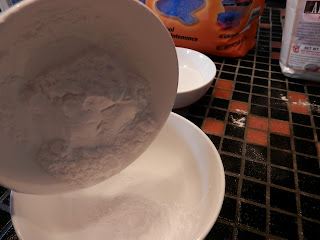Homemade Natural Deodorant
Conventional
deodorant/antiperspirants serve two
unhealthy functions:
1.
Clog underarm pores with aluminum to prevent sweat
2.
Mask odor with a chemical-created fragrance
They do this with chemicals that have been linked to Alzheimer’s disease, kidney failure, and breast cancer. To learn more about the harmful ingredients found in deodorants/antiperspirants read this article.
They do this with chemicals that have been linked to Alzheimer’s disease, kidney failure, and breast cancer. To learn more about the harmful ingredients found in deodorants/antiperspirants read this article.
Homemade deodorant is made with natural products that do not clog your underarm pores. Unclogged pores are necessary for your body to regulate temperature and remove toxins. Sweating is a natural process, but there are natural healthy ways to prevent odor and wetness.
The
base ingredient used in homemade deodorant will depend on the desired type
application and consistency. I will show you how to make two types of deodorants with coconut oil and 100% PURE cocoa
butter. Coconut oil is creamy in texture which is best applied with your fingers and 100% PURE cocoa butter is a solid which is applied with a deodorant applicator stick. Before picking a base keep in mind the different melting points of each: 100% PURE cocoa butter melts at 93–100 °F and coconut oil melts at 76 °F.
Each ingredient serves a natural purpose:
Baking
soda:
Neutralizes odor; Baking soda can be an irritant especially for those with
sensitive skin, if this is an issue leave this ingredient out and replace it
with your choice of starch.
Arrowroot
powder or cornstarch:
A starch to absorb wetness
Tea
tree oil:
Anti-bacterial; kills bacteria - the source of body odor
Vitamin
E oil:
Preservative and moisturizer
Coconut
oil: A
base to hold the ingredients together; Anti-bacterial - kills odor caused from
bacteria
Cocoa
butter: A
base to hold the ingredients together; Antioxidant that
fight free radicals, which protect your skin from pollutions and aging
Creamy Deodorant:
You will need:
Coconut oil, baking soda, arrowroot powder (or cornstarch), tea tree oil, vitamin E, essential oil, a disinfected container or deodorant applicator, and a spoon.
Homemade Natural Deodorant:
Homemade Natural Deodorant:
2 tablespoons baking soda
1/4 cup arrow powder
1 ounce base - coconut oil or 100% PURE cocoa butter
5 drops tea tree oil
2 drops vitamin E oil
Desired amount of essential oil for fragrance
Total time: 10 minutes
Total time: 10 minutes
Step 1: Combine the 2 tablespoons of baking soda and 1/4 cup of arrowroot powder and mix
Step 2: Add 1 ounce of coconut oil and mash together the ingredients. If coconut oil is hard melt in microwave or a double boiler.
Step 3: Mix 5 drops of tea tree oils, 2 drops of vitamin E oil, and essential oil
The final product should feel like a moistened snow ball.
Step 4: Store in an air tight container. To apply, rub a small amount under your arm.
Solid Deodorant:
You will need:
100% PURE Cocoa Butter, baking soda, arrowroot powder (or cornstarch), tea tree oil, vitamin E, essential oil, a disinfected deodorant applicator, and a spoon.
100% PURE cocoa butter is hard, so you will need to melt it in a double boiler.
Once melted, follow the same directions as for the creamy deodorant.
To use a deodorant applicator, make
sure the plate inside does not have holes. These holes will cause the
deodorant to drip through before it forms a solid. I use an old Tom's deodorant
applicator. Wash and disinfect applicator after every use.
Once deodorant is made, quickly fill the applicator
before deodorant hardens. With the plate pushed to the bottom, scoop or pour
the mixture inside the applicator. Tap down the container to push down the
deodorant and prevent gaps. Finally, place deodorant in freezer for several
minutes to let harden.
Final product is stiff but easily rubbed on the underarm with the deodorant applicator stick.
Tips:
1. You can use the deodorant applicator for both
recipes, however the creamy deodorant will smear when applied. If this
happens rub excess into your skin.
2. If using creamy deodorant in a deodorant
applicator stick do not roll the deodorant up too far. This will prevent the excess from smearing.
3. You can replace coconut oil with cocoa butter,
shea butter, beeswax, 100% aloe vera gel, or any other natural cream.
4. When traveling, place deodorant in a zip lock
bag in case the temperatures cause the deodorant to melt.
5. If solid deodorant is too hard, soften the next batch with a tablespoon of coconut oil.
6. To prevent the coconut oil from melting in the summer months store the deodorant in the refrigerator.
5. If solid deodorant is too hard, soften the next batch with a tablespoon of coconut oil.
6. To prevent the coconut oil from melting in the summer months store the deodorant in the refrigerator.
If you try this recipe allow your body 7 days to
transition and purge the clogged pores.
I challenge you to try this recipe! Let me know in the comments how it worked for you!


















